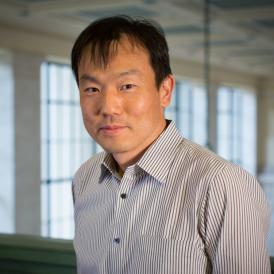
Lab Website:
Email:
Office:
Phone:
Administrative Assistant:
Courses:
Research-at-a-glance:
Affiliations:
Biography:
Professor Jongyoon Han is the principal investigator of Micro/Nanofluidic BioMEMS Group in the Research Laboratory of Electronics (RLE) at MIT. He received a B.S. and a M.S. degree from the Department of Physics of Seoul National University, Seoul, Korea. Han received his PhD from the School of Applied and Engineering Physics at Cornell University. Before joining BE, Professor Han was a research scientist at Sandia National Laboratories where he studied protein microfluidic separation systems.
Research:
Our understanding of biological systems critically depend on the tools available to analyze biomolecules and sub-cellular biological components. Advances in modern biology generally coincide with breakthroughs in our ability to separate and identify the target biomolecules out of a highly complex intracellular milieu of diverse biomolecules. The Micro/Nanofluidic BioMEMS group's research is focused at developing new tools and technologies for biomolecule separation and analysis using advanced microfluidics and nanofluidics. Toward the eventual goal of all-integrated microfluidic biomolecule analysis systems, currently the lab is focusing on four different areas.
First, the lab is interested in biomolecule separation using nanofluidic molecular sieve. Currently, most of biomolecule purification and separation uses random nanoporous materials as molecular sieving matrix. They are developing MEMS(Micro-Electro-Mechanical System)-based nanofluidic molecular sieves that can filter and separate various biomolecules based on their size or charge density. Unlike polymeric gels or nanoporous molecular filters, nanofluidic molecular sieves and filters could be engineered to have precise physical and chemical characteristics, therefore can have higher separation efficiency and selectivity.
Second, the Micro/Nanofluidic BioMEMS group is studying biomolecule and cell concentration / sensing using ion selective membranes. Ion selective membranes, such as nanofluidic channels and charged gels, can create the phenomenon of ion concentration polarization (ion depletion), which moves around ions and charged molecules in a controllable manner in a microfluidic system. They have developed various biomolecule and cell concentration devices using this phenoemenon, enabling higher detection sensitivities for immuoassays, enzyme activity assays, and cell based assays.
Third, the lab is developing novel methods for small-scale seawater desalination. Using the ion concentration polarization, the Han group has developed an energy efficient but scalable seawater desalination and water purification system. The separation mechanism is applicable to a broad class of contaminants, including salts, heavy metal ions, virus and bacteria particles, and other colloid in a single step operation. The energy efficiency of this desalination process is comparable to the current state-of-the-art large scale reverse osmosis, but the technology is scalable and miniature-izable, ideally suited for portable, self-powered water purification, for remote and disaster relief applications.
Finally, researchers in the Micro/Nanofluidic BioMEMS group are interested in electrochemical modulation of nerve cells using ion selective membranes. Ion selective membranes can be used to convert electric signals into electrochemical ones, by modulating ion concentrations near the nerve cells. The lab is currently studying the method of locally modulating various ion concentrations near the nerve cells, in order to change the nerve cells’ excitability on demand. This could have broad implications in neural prosthetics engineering, by facilitating low-current nerve stimulation and inactivation for the next generation neural prosthetics.


